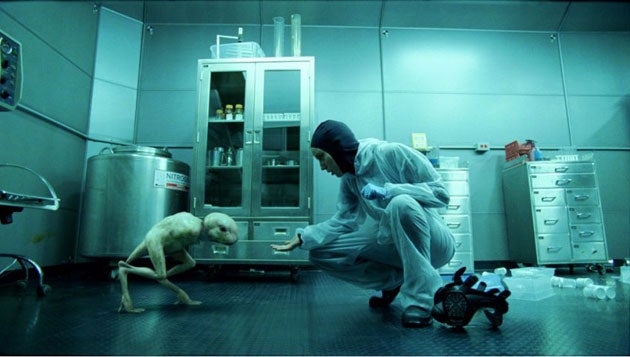Splice (15)
Just a crazy, mixed-up kind of kid

The thing about Frankenstein's monster wasn't that he was monstrous but that he had human feelings. He couldn't stand rejection. He didn't like people shrieking in horror at him. He was a sensitive soul. But how would the doctor's creation have behaved if he'd been created as a baby, had grown up with humanoid attributes and emotions (while still retaining his monstrous qualities) and then discovered love? This is the ingenious conundrum behind Splice, a fabulous piece of baroque film-making. It offers an echo-chamber of allusions to other horror-sci-fi movies, but brings its own style and pitch-dark humour to one of the oldest themes: the responsibility of playing God.
Adrien Brody and Sarah Polley are husband-and-wife genetic engineers Clive and Elsa, working for a US pharmaceuticals company. Their special expertise is to splice together DNA from different animals to create hybrid organisms that can yield up new vaccines for a range of diseases, and make a fortune for the company. We have the first inkling of the film's deadpan humour when Clive poses for a photograph, lovingly cradling his newest hybrid, Fred – a huge, revolting, faceless grey slug the size of a St Bernard.
Elsa, his wife, wants to take things further. She wants to put human DNA together with animals, to see what would result. The company, shrewdly noting that such experimentation is illegal, forbids them. But impulsive Elsa goes ahead. "What's the worst that can happen?" she asks, not for the last time. You don't need to comprehend all the science stuff; all you need to know is that something's been impregnated in a glass vitrine and it's comin' to get ya.
All hell breaks loose in the laboratory as the organism is born. It resembles, at the start, a vicious leg of lamb with a long thrashing tail. From inside it, there emerges an even scarier object that whizzes about the lab on duck legs, wailing horribly. Film buffs will sit quietly ticking off the ancestry of the beast: ET, Alien, The Fly, The Thing, the grotesque baby in Eraserhead. Vincenzo Natali is shameless about his borrowings: there's a scene in which Clive's younger brother tries to investigate whatever secret experiment is adsorbing his brother and, as he peers around corners, a long prehensile tail unfurls behind him – just as another tail unfurled behind the extremely doomed Harry Dean Stanton in Alien.
And so we meet H50, half-human, half-unspecified animal, all dangerous. One of the film's finest virtues is that, while the creature is growing, we see its animal qualities (a puppy, a lamb) while we start to detect a human inside its scary features. Gradually, it resolves into a little girl, called Dren, with eyes on the side of her head and a black stripe along her cerebellum.
The more Elsa is entranced by her creation – her daughter – the more Clive tries to remind her they've invented a dangerous alien. Interrupting Elsa as she teaches Dren (in a sweet blue frock) to read, he yells: "What's she doing in this room? You can't let her out. Specimens need to be contained." You can feel Elsa flinch from that word "specimens". You can hear the ambiguity in Clive's use of the word "her". The fact that the scientists are husband and wife leads us into parental territory; we learn about Elsa's awful childhood, her horrible mother and reluctance to have a child by the usual methods.
As Clive is harassed by the drug company, impatient to see some pharmaceutical results from all the research, Elsa dotes on the rapidly-growing hybrid, whose life-cycle is accelerated, and who has reached a sexy teen stage (played by Delphine Chanéac). You know the kind of look: shaved head, forked tongue, long tail, bendy kangaroo legs, retractable wings. These are perhaps the film's best scenes, when the sweet mother-daughter bonding is undercut by the knowledge in our heads that Dren isn't a girl, isn't real and could kill her mama at any moment. As Elsa applies lipstick and shows Dren how pretty she's become, she coos, "Of course this is a very special time for you...", and we silently shout back, 'Oh no it isn't. She's never going to, like, go to a prom.'
To beguile a dull quarter-hour in their barn-like hideaway, Clive plays a record and teaches Dren to dance. This is not a wise move. In quick succession she discovers movement, rhythm, holding hands, closeness. Her huge ET eyes grow alarmingly fond. When she and Adrien Brody have sex, it's shocking on several levels, but also inevitable – because, of course, there a further level of genetic splicing to be penetrated...
If you hadn't known that Guillermo del Toro was on board as an executive producer, you could have guessed it, from the confidence with which disgusting visuals are beautifully rendered. A second-reel highlight, showing two of Clive's baggy hybrids fighting to the death and spurting alien blood all over an audience of would-be investors is a model of stylish grotesquerie. But this film does something quite remarkable in the SF genre: it appeals to your emotions as much as your mind. It takes an idea of genetic mutation and works out its ramifications with perfect logic, but it also tugs at the heartstrings. We see Dren the hybrid through her human mother's eyes, even as we simultaneously know she's a monster. I don't know when I've had my emotions so monkeyed around with in the cinema. Vincenzo Natali's achievement is to take the viewer's heart and head, and effectively splice them together.
Anthony Quinn is away
Subscribe to Independent Premium to bookmark this article
Want to bookmark your favourite articles and stories to read or reference later? Start your Independent Premium subscription today.

Join our commenting forum
Join thought-provoking conversations, follow other Independent readers and see their replies